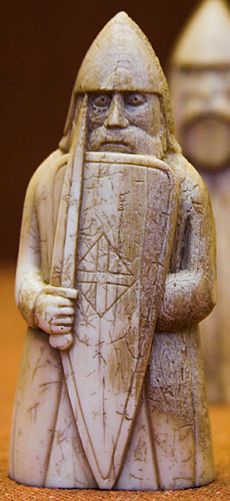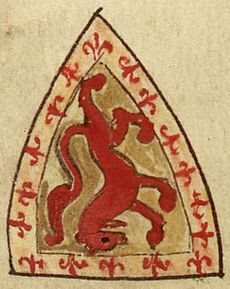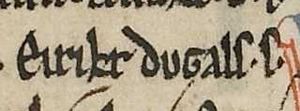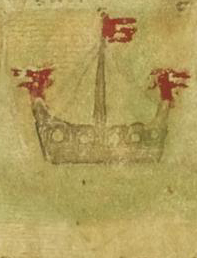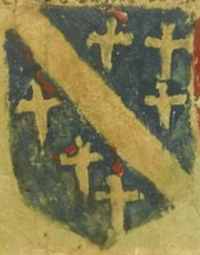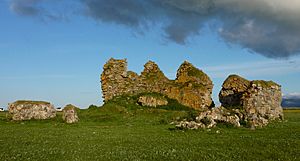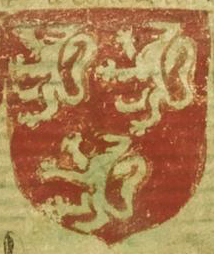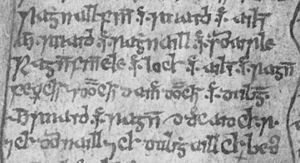Clann Ruaidhrí facts for kids
Clann Ruaidhrí was an important medieval family in the Hebrides and the western coast of Scotland. The family's name comes from Ruaidhrí mac Raghnaill, a key leader of Clann Somhairle in the 1200s.
Members of Clann Ruaidhrí played a big part in the history of both the Kingdom of the Isles and the Kingdom of Scotland during the 13th and 14th centuries. They likely held power in Kintyre in the 1200s. By the 1300s, they controlled a large area along the north-western Scottish coast and in the Hebrides islands.
At first, Clann Ruaidhrí strongly opposed Scottish rule. But when Norway lost its power in the region, the family cleverly joined forces with the Kingdom of Scotland.
Clann Ruaidhrí leaders were brave fighters in the First War of Scottish Independence. They fought against both the English and Scottish kings. Like other branches of Clann Somhairle, Clann Ruaidhrí was known for sending gallowglass warriors to Ireland. Gallowglasses were skilled, heavily armed soldiers.
By the mid-1300s, the family's power in Scotland and Ireland began to shrink. The last known gallowglass captain from the family was recorded in 1342. The last great chief of Clann Ruaidhrí was killed in 1346. After his death, the Clann Ruaidhrí lands went to the chief of Clann Domhnaill. This family was a distant relative from Clann Somhairle. These lands then became a big part of the Lordship of the Isles, which was ruled by Clann Domhnaill.
It seems that some parts of the Clann Ruaidhrí family continued to exist, but with much less power. One member might have held power as late as the early 1400s.
Clann Somhairle Family Tree
| Simplified pedigree of Clann Somhairle and Clann Ruaidhrí. Feminine names are italicised. Conjectured relationships are labelled with a question marks. The eponyms of Clann Dubhghaill, Clann Ruaidhrí, and Clann Domhnaill are highlighted. | ||||||||||||||||||||||||||||||||||||||||||||||||||||||||||||||||||||||||||||||||||||||||||||||||||||||||||||||||||||||||||||||||||||||||||||||||||||||||||||||||||||||||||||||||||||||||||||||||||||||||||||||||||||||||||||||||||||||||||||||||||||||||||||||||||||||||||||||||||||||||||||||||||||||||||||||||||||||||||||||||||||||||||||||||||||||||||||||||||||||||||||||||||||||||||||||||||||||||||||||||||||||||||||||||||||||||||||||||||||||||||||||||||||||||||||||||||||||||||||||||||||||||||||||||||||||||||||
|---|---|---|---|---|---|---|---|---|---|---|---|---|---|---|---|---|---|---|---|---|---|---|---|---|---|---|---|---|---|---|---|---|---|---|---|---|---|---|---|---|---|---|---|---|---|---|---|---|---|---|---|---|---|---|---|---|---|---|---|---|---|---|---|---|---|---|---|---|---|---|---|---|---|---|---|---|---|---|---|---|---|---|---|---|---|---|---|---|---|---|---|---|---|---|---|---|---|---|---|---|---|---|---|---|---|---|---|---|---|---|---|---|---|---|---|---|---|---|---|---|---|---|---|---|---|---|---|---|---|---|---|---|---|---|---|---|---|---|---|---|---|---|---|---|---|---|---|---|---|---|---|---|---|---|---|---|---|---|---|---|---|---|---|---|---|---|---|---|---|---|---|---|---|---|---|---|---|---|---|---|---|---|---|---|---|---|---|---|---|---|---|---|---|---|---|---|---|---|---|---|---|---|---|---|---|---|---|---|---|---|---|---|---|---|---|---|---|---|---|---|---|---|---|---|---|---|---|---|---|---|---|---|---|---|---|---|---|---|---|---|---|---|---|---|---|---|---|---|---|---|---|---|---|---|---|---|---|---|---|---|---|---|---|---|---|---|---|---|---|---|---|---|---|---|---|---|---|---|---|---|---|---|---|---|---|---|---|---|---|---|---|---|---|---|---|---|---|---|---|---|---|---|---|---|---|---|---|---|---|---|---|---|---|---|---|---|---|---|---|---|---|---|---|---|---|---|---|---|---|---|---|---|---|---|---|---|---|---|---|---|---|---|---|---|---|---|---|---|---|---|---|---|---|---|---|---|---|---|---|---|---|---|---|---|---|---|---|---|---|---|---|---|---|---|---|---|---|---|---|---|---|---|---|---|---|---|---|---|---|---|---|---|---|---|---|---|---|---|---|---|---|---|---|---|---|---|---|---|---|---|---|---|---|---|---|---|---|---|---|---|---|---|---|---|---|---|---|---|---|---|---|---|---|---|---|---|---|---|---|---|---|---|---|---|---|---|---|---|---|---|---|---|---|---|---|---|---|---|---|---|---|---|---|---|---|---|---|---|---|---|---|---|---|---|---|---|---|---|---|---|---|---|---|---|---|---|---|---|---|---|---|---|---|---|---|---|---|---|---|---|---|---|---|---|---|---|---|---|
|
||||||||||||||||||||||||||||||||||||||||||||||||||||||||||||||||||||||||||||||||||||||||||||||||||||||||||||||||||||||||||||||||||||||||||||||||||||||||||||||||||||||||||||||||||||||||||||||||||||||||||||||||||||||||||||||||||||||||||||||||||||||||||||||||||||||||||||||||||||||||||||||||||||||||||||||||||||||||||||||||||||||||||||||||||||||||||||||||||||||||||||||||||||||||||||||||||||||||||||||||||||||||||||||||||||||||||||||||||||||||||||||||||||||||||||||||||||||||||||||||||||||||||||||||||||||||||||
Clann Ruaidhrí was one of several important families that came from Clann Somhairle. Other major branches included Clann Dubhghaill and Clann Domhnaill. The founder of Clann Ruaidhrí was Ruaidhrí mac Raghnaill. He was the grandson of Somhairle mac Giolla Brighde, who was a powerful ruler known as the King of the Isles. Somhairle was the common ancestor of all Clann Somhairle families.
Ruaidhrí's father, Raghnall mac Somhairle, was also the father of Domhnall mac Raghnaill. Domhnall was the founder of Clann Domhnaill. Somhairle died suddenly in battle in 1164. His family controlled a huge amount of land. This might explain why Clann Somhairle quickly split into different rival groups.
Kingdom of the Isles
Ruaidhrí mac Raghnaill's Early Years

Ruaidhrí was probably the oldest of Raghnall's sons. He likely helped Thomas fitz Roland, Earl of Atholl in attacks against the Irish in 1211 and 1212. He definitely helped Thomas in destroying Derry and nearby areas in 1213 and 1214. These sea attacks might have been to help Rǫgnvaldr Guðrøðarson, the King of the Isles, who was facing problems.
The raids might also have been to help the Scottish and English kings. They wanted to stop Irish support for the Meic Uilleim, a rival branch of the Scottish royal family.
By the 1220s, Ruaidhrí might have been the most important member of Clann Somhairle. He seems to have arranged important marriages with two main leaders of the Crovan dynasty. This dynasty also ruled parts of the Isles. For example, King Rǫgnvaldr and his half-brother Óláfr married daughters of a nobleman from Kintyre. Ruaidhrí and his father were called "Lord of Kintyre." This suggests one of them was the father of the brides.
These marriages likely tried to fix relations between Clann Somhairle and the Crovan dynasty. These families had fought for about 60 years over who would be King of the Isles. Ruaidhrí probably accepted Rǫgnvaldr as king. This made Ruaidhrí a powerful lord in a reunited Kingdom of the Isles.
Most of Ruaidhrí's lands were on the mainland. So, the Scottish King Alexander II, King of Scotland likely saw this reunited island kingdom as a threat. This fear might have led to Ruaidhrí being forced out of Kintyre by Scottish royal forces in the early 1220s.
Dubhghall and Ailéan: New Leaders
Ruaidhrí might be the same Clann Somhairle leader, known only as Mac Somhairle, who was killed fighting an English invasion in Ireland in 1247. After this, Ruaidhrí's son, Dubhghall, became the leader of Clann Ruaidhrí. His family then fought against the English in Ireland.
In 1258, Dubhghall fought and killed Jordan d'Exeter, an English sheriff in Ireland. The next year, Aedh mac Felim Ó Conchobair, the son of the King of Connacht in Ireland, married Dubhghall's daughter. As a wedding gift, he received 160 gallowglass warriors led by Dubhghall's younger brother, Ailéan. Ailéan was one of the first known gallowglass warriors.
Dubhghall's sea attacks and this marriage alliance were part of a plan. They aimed to challenge English power in north-west Ireland. However, Aodh na nGall and his allies were badly defeated in the Battle of Druim Dearg in 1260. Clann Ruaidhrí gallowglasses likely fought in this battle.
In 1248, the year after Mac Somhairle's death, Dubhghall and Eoghan Mac Dubhghaill, the chief of Clann Dubhghaill, both traveled to Norway. They wanted King Hákon Hákonarson, King of Norway to make them king of the northern Isles. The "Suðreyjar" (Southern Isles) included the Hebrides and Mann. It's not clear exactly which islands Dubhghall and Eóghan wanted to rule.
After Haraldr, the King of the Isles, died unexpectedly in 1248, Hákon sent Eóghan to temporarily rule the Isles for him. But Eóghan was also a powerful Scottish lord on the mainland. Scotland had tried to buy the Isles earlier. When Eóghan accepted Hákon's offer, King Alexander II of Scotland invaded Argyll in 1249. This attack was aimed at the heart of Clann Dubhghaill's lands.
The crisis ended when Alexander II died suddenly in July 1249. Eóghan seems to have lost all his lands to the Scots. This might have changed the power order within Clann Somhairle. In the same year Eóghan lost Argyll, Dubhghall is recorded as having "took kingship" in the Isles. This could mean Dubhghall took over from a weakened Eóghan.
After Alexander II died in 1249, the Scottish invasion stopped. About ten years later, his son, Alexander III, became old enough to rule. He wanted to continue his father's plan to expand west. In 1261, Scotland offered to buy the Hebrides from Norway. When Norway refused, the Scots attacked the people of Skye very harshly.
This made King Hákon gather a huge fleet to show Norway's power again in Scotland. In July 1263, his fleet left Norway. By mid-August, Hákon had control in Shetland and Orkney. He also forced Caithness to submit and arrived in the Hebrides.
Both Dubhghall and Ailéan played a big part in Hákon's campaign against the Scots. Even though a Norwegian source said it was a great victory, it seems to have been a failure. Hákon did not break Scottish power. Instead, Alexander III attacked the Isles and northern Scotland the next year.
Seeing this shift in power, Magnús Óláfsson, the King of Mann and the Isles, surrendered to Alexander III. This showed that Norway had completely lost control of the Isles. Dubhghall, however, refused to surrender to Scotland. He continued to fight, but it was useless. The Norwegian Crown was finally forced to give the Isles to Scotland in 1266.
Dubhghall's main power base might have been in Garmoran and Uist. But it's not clear how or when his family got these lands. Later Clann Ruaidhrí leaders definitely owned these lands. But there's no proof they had them before the mid-1200s. These lands might have been given to them after Scotland took the Isles in 1266. Or, the family's power in Garmoran and the Hebrides might have come from their marriages with the Crovan dynasty. This happened before Ruaidhrí was forced out of Kintyre.
Another family member might have been Ruðri. He and his two brothers swore loyalty to Hákon in 1263. They also helped in Hákon's overseas campaign. Ruðri claimed Bute as his birthright. He received the island from the Norwegian king after the 1263 campaign.
Kingdom of Scotland
Ailéan mac Ruaidhrí's Rise
After Scotland took the Isles, and Dubhghall died, Clann Ruaidhrí disappeared from Scottish records for a while. When they reappeared in 1275, it was through Ailéan. By then, he was an important Scottish lord and the leader of Clann Ruaidhrí.
That year, Magnús's son, Guðrøðr Magnússon, led a revolt on Mann against Scotland. King Alexander III sent a huge army to restore his power. Two of the Scottish commanders were from Clann Somhairle: Alasdair Mac Dubhghaill, Lord of Argyll, and Ailéan himself. Their role as Scottish agents shows how much Clann Somhairle had become part of the Scottish kingdom.
In 1284, Ailéan was one of many Scottish lords who attended a council. They recognized Margaret, Maid of Norway, Alexander III's granddaughter, as the rightful heir to the throne. Ailéan's presence, along with two other Clann Somhairle relatives, showed their importance in Scotland.
Lachlann and Ruaidhrí: Wars and Alliances
In 1293, King John, King of Scotland created new sheriffdoms to keep peace in the west. A sheriffdom is an area controlled by a sheriff, who enforces the king's law. The Skye region was given to William II, Earl of Ross. This area included Skye, Lewis and Harris, Uist, and other islands. The Lorn region was given to Alasdair Mac Dubhghaill. This area included Argyll, Mull, Jura, and Islay.
The king wanted peace, but his new sheriffs used their power against local rivals. Clann Ruaidhrí seems to have had problems with the Earl of Ross. They fought over control of Kintail, Skye, and Uist. Letters from 1304 show the Earl of Ross had a costly military campaign in the 1290s. He fought against rebellious island chiefs, including Lachlann, for King John.
Ailéan seems to have died before 1296. That year, King Edward I, King of England invaded and conquered Scotland. Alasdair Mac Dubhghaill had been a strong supporter of the Scottish king. So, Edward I used Alasdair's rival, Alasdair Óg Mac Domhnaill, as his main agent in the west. This Clann Domhnaill chief tried to stop the Clann Dubhghaill revolt against English rule.

Letters from Alasdair Óg to Edward I show the fight between the two Clann Somhairle families. They reveal that Clann Ruaidhrí fought against Clann Domhnaill, allied with Clann Dubhghaill. They also show cooperation with the Comyn kindred, another powerful family. These letters suggest that Lachlann and Ruaidhrí wanted to take control of Skye and Lewis and Harris from the Earl of Ross. The Earl was imprisoned in England from 1296 to 1303.
The bitter fighting between Clann Ruaidhrí and Clann Domhnaill shows that both families wanted to take advantage of the Earl's absence. They both wanted to add the islands to their own lands. For Clann Ruaidhrí, their fighting was likely a continuation of the conflict that started when the sheriffdom of Ross was created in 1293.
There is more evidence of Clann Ruaidhrí working with the Comyns in 1299 and 1304. Two years later, Robert Bruce VII, Earl of Carrick, who wanted to be King of Scotland, killed his main rival, John Comyn III of Badenoch. Robert became King Robert I in March. But the English king immediately fought back, defeating Robert's forces in June. By September, Robert I was a fugitive, hiding in the Hebrides.
An old chronicle from the 1300s says that Ailéan's daughter, Cairistíona, helped Robert I survive during this difficult time. She sheltered him along Scotland's western coast.
Ruaidhrí Mac Ruaidhrí and Cairistíona Nic Ruaidhrí
Lachlann disappears from records in the 1310s. His brother, Ruaidhrí, seems to have taken over as chief. Even though Cairistíona was Ailéan's only legitimate child, Clann Ruaidhrí probably didn't only consider legitimate birth for succession. Ruaidhrí, as the leading male, likely controlled the family's lands. However, Ruaidhrí seems to have only officially gained control after Cairistíona gave up her claims.
Cairistíona's claim to the lands might have been a threat to Ruaidhrí and his children. She was married to a member of the Mar family, who were related to King Robert I. Cairistíona and her husband had a son named Ruaidhrí. He could have asked the king for help to pursue his mother's claims. Naming him Ruaidhrí might mean he was named after his grandfather and seen as a possible future leader of Clann Ruaidhrí. Cairistíona gave up her claims with a condition: if her brother died without a male heir, her son (also named Ruaidhrí) would inherit the lands.
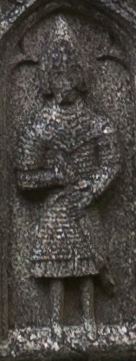
The king might have helped Ruaidhrí become chief to gain support from a powerful family on the west coast. Or, it could be that Ruaidhrí's control was due to internal family politics. Cairistíona was a close ally of Robert I, but Ruaidhrí had a more complicated past. Either way, Ruaidhrí was likely already seen as the rightful chief. The official document made him a feudal dependent of the Scottish Crown. This meant he owed loyalty and service to the king for his lands.
Ruaidhrí's lands included Moidart, Arisaig, Morar, and Knoydart on the mainland. It also included the islands of Rhum, Eigg, Barra, St Kilda, and Uist. This area was as large and important as any of the kingdom's earldoms.
Ruaidhrí seems to have helped Scotland fight the English in Ireland. He might have died in the Scottish defeat at the Battle of Faughart in 1318. Several old Irish records mention a "Mac Ruaidhri, king of the Isles" and a "Mac Domnaill, king of Argyll" being killed. The exact identities are not certain, but they seem to have been the chiefs of Clann Ruaidhrí and Clann Domhnaill. The "Mac Ruaidhri" might have been Ruaidhrí himself.
Clann Ruaidhrí also fought in another major battle. This was the final defeat of Ruaidri Ó Conchobair, the King of Connacht, by Felim McHugh O'Connor. A man named Donnchadh Mac Ruaidhrí and 100 gallowglasses died with the king. One record calls these gallowglasses "noble." The next year, in 1317, Clann Ruaidhrí was part of another defeat. The forces of Connacht defeated those of Bréifne. One record says 140 gallowglasses of a "Mac Ruaidri" were killed.
Raghnall and Cairistíona: A Contested Inheritance
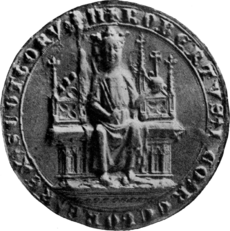
Ruaidhrí tried to ensure his family's future by making peace with Robert I and fighting in Ireland. But after he died, Cairistíona seems to have challenged the Clann Ruaidhrí inheritance. Ruaidhrí had a daughter, Áine, and an illegitimate son, Raghnall. Raghnall might have been too young when Ruaidhrí died. Cairistíona and her allies tried to take control of the inheritance.
Cairistíona is recorded as giving up her claims to a man named Artúr Caimbéal after Ruaidhrí's death. However, Raghnall eventually gained control of the region. Most of his relatives saw him as the chief of Clann Ruaidhrí.
In 1325, a "Roderici de Ylay" lost his lands by order of Robert I. This might refer to a Clann Ruaidhrí member. It could show how relations between Clann Ruaidhrí and the Scottish Crown changed in the 1320s and 1330s. If this was Raghnall, his loss of lands might be linked to Cairistíona's attempt to give the Clann Ruaidhrí estate to the Caimbéalaigh family (the Campbells). Another idea is that he lost the lands because Clann Ruaidhrí expanded into neighboring areas, like the former lands of the Clann Dubhghaill, who had lost their power.
Cairistíona's document giving her rights to Artúr has no date. It might be from just before the forfeiture. The list of witnesses to this document is important. It might show that the king approved the transfer. These witnesses were all close allies of Robert I against Clann Dubhghaill. They represented powerful families along the western coast. An alliance of such men would have been very intimidating to the Clann Ruaidhrí leaders. The forfeiture might even have been personally enforced by Robert I. The king seems to have traveled to Tarbert Castle, a royal stronghold in Kintyre, in the same year.
Unlike the First War of Scottish Independence, Raghnall and his family are not known to have fought in the Second War of Scottish Independence (1332–1341). Raghnall is definitely mentioned in 1337. He helped his cousin, Eóin Mac Domhnaill I, Lord of the Isles, get permission from the Pope to marry Raghnall's sister, Áine. At that time, Raghnall and Eóin supported Edward Balliol, who claimed the Scottish throne.
By June 1343, both Raghnall and Eóin had made peace with Edward's rival, King David II, King of Scotland, who was Robert I's son. King David II confirmed Raghnall's rights to the Clann Ruaidhrí lands.
Around this time, Raghnall received the rights to Kintail from William III, Earl of Ross. The king confirmed this deal in July. The king's approval of this grant might have been to balance power in the region. He also gave the rights to Skye from Eóin to William III. It's also possible that Clann Ruaidhrí's power had grown into Kintail after the death of William III's father in 1333. This was a time when William III might have been young or exiled. Whatever the reason, the Earl seems to have had no choice but to give up his rights to Kintail to Raghnall.
There seems to have been strong dislike between these two powerful lords. This led to Raghnall and several of his followers being killed by the Earl and his men. Raghnall's murder happened at Elcho Priory in October 1346. Several old records mention this event. When he died, Raghnall was gathered with the king's army at Perth. They were preparing for Scotland's invasion of England.
After the murder, William III left the royal army and fled to his own lands. He later paid a high price for this disloyalty. But the event shows how determined the Earl was to deal with Clann Ruaidhrí's growing power in his lands. Even though William III removed his main rival, the biggest winner from the killing was Eóin, who was also William III's brother-in-law.
The Family's Decline
After Raghnall's death, control of the Clann Ruaidhrí lands went to Eóin through his marriage to Áine. Even though Áine seems to have died or divorced Eóin by 1350, the Clann Ruaidhrí lands stayed with Clann Domhnaill. This was true even after Eóin married Margaret, the daughter of Robert Stewart, Steward of Scotland.
King David II died in 1371. His uncle, Robert Stewart, became King Robert II. In 1372, the new king confirmed Eóin's rights to the former Clann Ruaidhrí lands. The next year, Robert II confirmed Eóin's gift of these lands to Raghnall Mac Domhnaill. He was Eóin and Áine's oldest surviving son. He was likely named after Raghnall Mac Ruaidhrí. Raghnall Mac Domhnaill became the founder of the Clann Raghnaill branch of Clann Domhnaill.
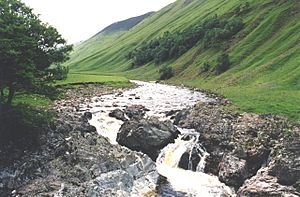
Even though their power was greatly reduced, there is evidence that Clann Ruaidhrí continued for several generations. Members of the family were known as gallowglasses in Ireland around this time. One gallowglass commander, who served Toirdelbach Ó Conchobair, the King of Connacht, was killed in 1342. Records mentioning this man are the last to specifically note Clann Ruaidhrí gallowglasses in Ireland.
It's possible that a man named Eóghan, who was given the lands of Glen Tilt by Robert Stewart before 1346, was Raghnall and Áine's brother. He might have been brought back to Scotland from Ireland to serve the growing military forces of the Steward. Like in Scotland, the main ruling line of Clann Ruaidhrí seems to have faded away in Ireland in the 1300s.
However, the family continued into later centuries. This is shown by the executions in the 1400s of Alasdair Mac Ruaidhrí and Eóin Mac Artair. These chiefs were said to command 1,000 men each. Cairistíona's attempt to give the Clann Ruaidhrí lands to Artúr Caimbéal almost a century before might mean that Alasdair Mac Ruaidhrí and Eóin Mac Artair continued a feud. This feud would have come from Cairistíona's disputed inheritance and her connections with the Caimbéalaigh.
Another family that might have benefited from connections to Clann Ruaidhrí was Clann Néill of Barra. In 1427, Giolla Adhamhnáin Mac Néill was given Barra and Boisdale by Alasdair Mac Domhnaill, Lord of the Isles. Giolla Adhamhnáin's father was Ruaidhrí Mac Néill, who is mentioned in records in 1409.
Ruaidhrí Mac Néill seems to be the first Clann Néill member with a name linked to Clann Ruaidhrí. Also, Giolla Adhamhnáin held Barra and Boisdale, which were islands formerly controlled by Clann Ruaidhrí. This could mean Clann Néill's right to these lands came through a female descendant of Clann Ruaidhrí. This might mean Ruaidhrí Mac Néill's father, Murchadh Mac Néill, married one of Raghnall's daughters.
Another possibility is that Giolla Adhamhnáin's document suggests his family got the lands through his maternal grandmother. She could have been a Clann Ruaidhrí heiress. Or, Clann Néill's claim to the region might have come from a marriage alliance with Clann Domhnaill. An old history from the 1600s says that Clann Néill gained Boisdale from Áine's son, Gofraidh Mac Domhnaill.




